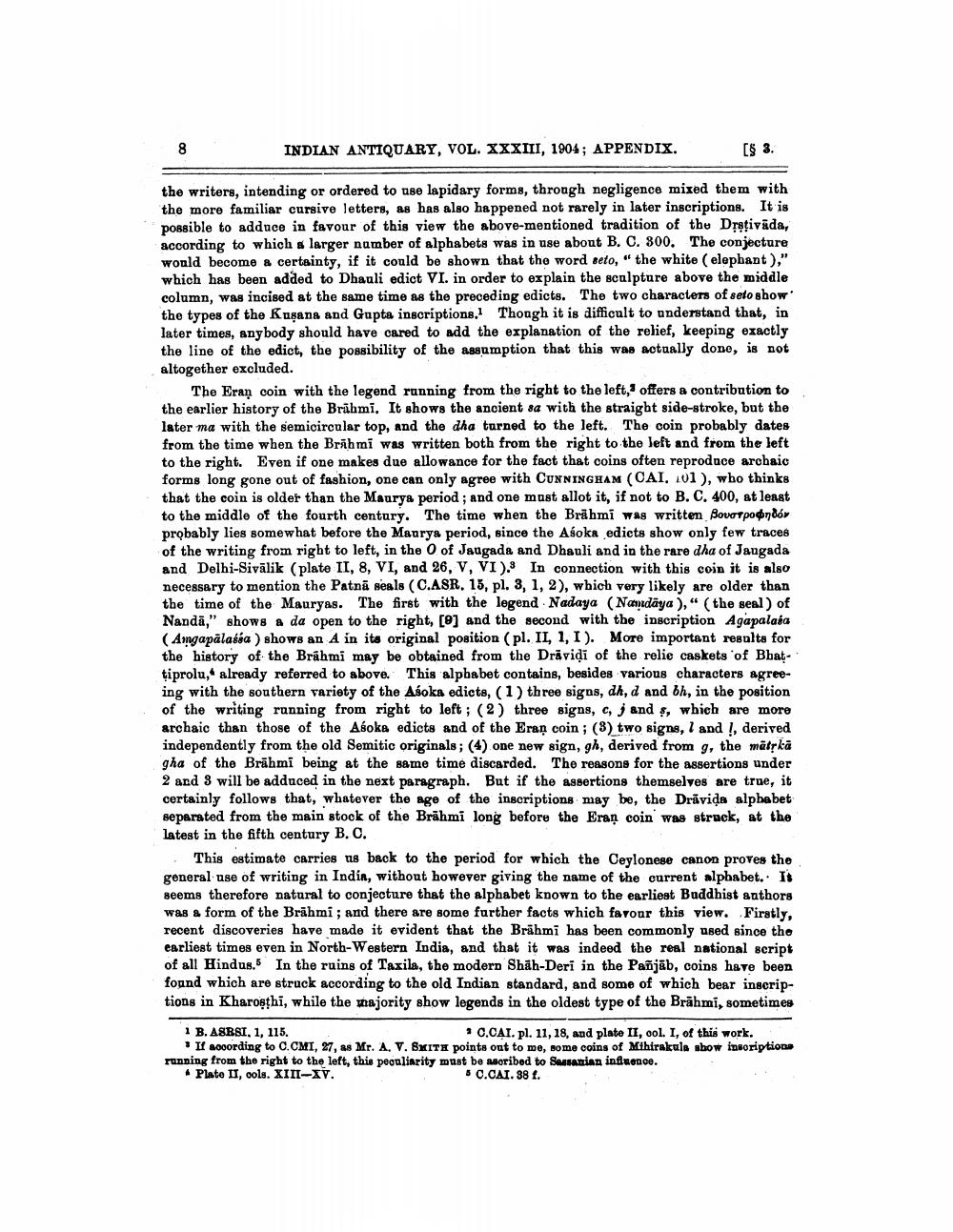________________
8
INDIAN ANTIQUARY, VOL. XXXIII, 1904; APPENDIX.
[§ 3.
the writers, intending or ordered to use lapidary forms, through negligence mixed them with the more familiar cursive letters, as has also happened not rarely in later inscriptions. It is possible to adduce in favour of this view the above-mentioned tradition of the Dṛṣṭivada, according to which a larger number of alphabets was in use about B. C. 300. The conjecture would become a certainty, if it could be shown that the word seto, " the white (elephant)," which has been added to Dhauli edict VI. in order to explain the sculpture above the middle column, was incised at the same time as the preceding edicts. The two characters of seto show the types of the Kusana and Gupta inscriptions. Though it is difficult to understand that, in later times, anybody should have cared to add the explanation of the relief, keeping exactly the line of the edict, the possibility of the assumption that this was actually done, is not altogether excluded.
The Eran coin with the legend running from the right to the left, offers a contribution to the earlier history of the Brahmi. It shows the ancient sa with the straight side-stroke, but the later ma with the semicircular top, and the dha turned to the left. The coin probably dates from the time when the Brahmi was written both from the right to the left and from the left to the right. Even if one makes due allowance for the fact that coins often reproduce archaic forms long gone out of fashion, one can only agree with CUNNINGHAM (CAI. 101), who thinks that the coin is older than the Maurya period; and one must allot it, if not to B. C. 400, at least to the middle of the fourth century. The time when the Brahmi was written Bovarρonó probably lies somewhat before the Maurya period, since the Aśoka edicts show only few traces of the writing from right to left, in the O of Jaugada and Dhauli and in the rare dha of Jangada and Delhi-Sivälik (plate II, 8, VI, and 26, V, VI). In connection with this coin it is also necessary to mention the Patna seals (C.ASR. 15, pl. 3, 1, 2), which very likely are older than the time of the Mauryas. The first with the legend Nadaya (Nandaya), " (the seal) of Nanda," shows a da open to the right, [9] and the second with the inscription Agapalasa (Angapalassa) shows an A in its original position (pl. II, 1, 1). More important results for the history of the Brahmi may be obtained from the Draviḍi of the relie caskets of Bhat-tiprolu, already referred to above. This alphabet contains, besides various characters agreeing with the southern variety of the Asoka edicts, (1) three signs, dh, d and bh, in the position of the writing running from right to left; (2) three signs, c, j and s, which are more archaic than those of the Aśoka edicts and of the Eran coin; (3) two signs, I and !, derived independently from the old Semitic originals; (4) one new sign, gh, derived from g, the matṛkā gha of the Brahmi being at the same time discarded. The reasons for the assertions under 2 and 3 will be adduced in the next paragraph. But if the assertions themselves are true, it certainly follows that, whatever the age of the inscriptions may be, the Dravida alphabet separated from the main stock of the Brahmi long before the Eran coin was struck, at the latest in the fifth century B. C.
This estimate carries us back to the period for which the Ceylonese canon proves the general use of writing in India, without however giving the name of the current alphabet. It seems therefore natural to conjecture that the alphabet known to the earliest Buddhist authors was a form of the Brahmi; and there are some further facts which favour this view. Firstly, recent discoveries have made it evident that the Brahmi has been commonly used since the earliest times even in North-Western India, and that it was indeed the real national script of all Hindus. In the ruins of Taxila, the modern Shah-Deri in the Pañjab, coins have been found which are struck according to the old Indian standard, and some of which bear inscriptions in Kharosthi, while the majority show legends in the oldest type of the Brahmi, sometimes
1 B. ASBSI, 1, 115.
C.CAI. pl. 11, 18, and plate II, col. I, of this work. If according to C. CMI, 27, as Mr. A. V. SMITH points out to me, some coins of Mihirakula show inscriptions running from the right to the left, this peculiarity must be ascribed to Sassanian influence. * Plate II, cols. XIII-XV. 5 C.CAI. 38 f.




